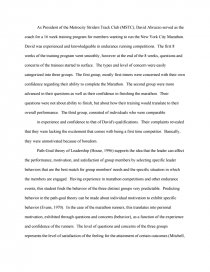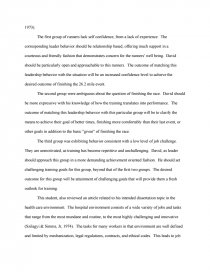Marathon Runners at Different Levels
Essay by Greek • April 6, 2011 • Essay • 644 Words (3 Pages) • 5,197 Views
As President of the Metrocity Striders Track Club (MSTC), David Abruzzo served as the coach for a 16 week training program for members wanting to run the New York City Marathon. David was experienced and knowledgeable in endurance running competitions. The first 8 weeks of the training program went smoothly, however at the end of the 8 weeks, questions and concerns of the trainees started to surface. The types and level of concern were easily categorized into three groups. The first group, mostly first-timers were concerned with their own confidence regarding their ability to complete the Marathon. The second group were more advanced in their questions as well as their confidence in finishing the marathon. Their questions were not about ability to finish, but about how their training would translate to their overall performance. The third group, consisted of individuals who were comparable
in experience and confidence to that of David's qualifications. Their complaints revealed that they were lacking the excitement that comes with being a first time competitor. Basically, they were unmotivated because of boredom.
Path-Goal theory of Leadership (House, 1996) supports the idea that the leader can affect the performance, motivation, and satisfaction of group members by selecting specific leader behaviors that are the best match for group members' needs and the specific situation in which the members are engaged. Having experience in marathon competitions and other endurance events, this student finds the behavior of the three distinct groups very predictable. Predicting behavior in the path-goal theory can be made about individual motivation to exhibit specific behavior (Evans, 1970). In the case of the marathon runners, this translates into personal motivation, exhibited through questions and concerns (behavior), as a function of the experience and confidence of the runners. The level of questions and concerns of the three groups represents the level of satisfaction of the feeling for the attainment of certain outcomes (Mitchell, 1973).
The first group of runners lack self confidence, from a lack of experience. The corresponding leader behavior should be relationship based, offering much support in a courteous and friendly fashion that demonstrates concern for the runners' well being. David should be particularly open and approachable to this runners. The outcome of matching this leadership behavior with the situation will be an increased confidence level to achieve the desired outcome of finishing the 26.2 mile event.
The second group were ambiguous about the question of finishing the race. David should be more expressive with his knowledge of how the training translates into performance. The outcome of matching this leadership behavior with this particular group will be to clarify the means to achieve their goal of better times, finishing more comfortably than their last event, or other
...
...


